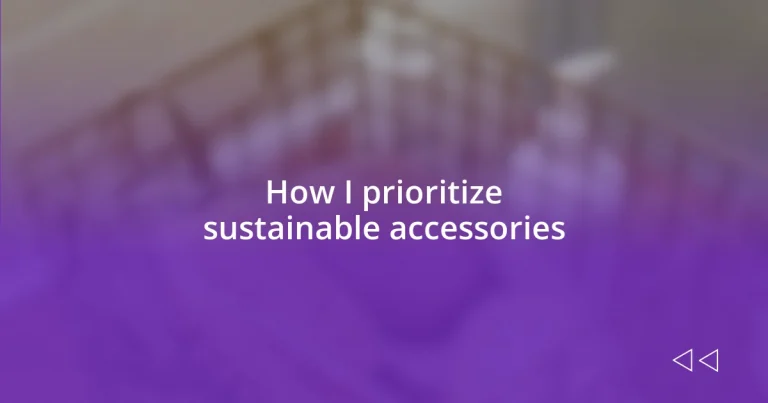Key takeaways:
- Understanding the impact of materials and production methods is crucial for making sustainable fashion choices.
- Prioritizing longevity and ethical brands enhances both personal style and environmental responsibility.
- Cultivating a sustainable shopping mindset transforms shopping from impulsive habits into thoughtful, value-driven investments.

Understanding sustainable fashion choices
When I first ventured into the world of sustainable fashion, I felt overwhelmed by the myriad of choices. One key realization was that understanding the impact of fabrics and production methods is crucial. For instance, I remember the moment I learned how organic cotton uses far less water than conventional cotton. It made me rethink my purchases entirely and appreciate the craftsmanship behind what I wear.
The emotional connection we have with fashion is often tied to identity and self-expression, but have you ever paused to consider how those choices affect the planet? I’ve found that shifting my mindset to prioritize sustainability not only lightens my environmental footprint but also enriches my personal style. Choosing thrifted pieces or brands that align with eco-friendly practices feels like a small rebellion against fast fashion, and it’s incredibly liberating.
Engaging with sustainable fashion choices has opened my eyes to the broader implications of my wardrobe. For example, when I chose a backpack made from recycled materials, it wasn’t just a purchase; it became a conversation starter about sustainability. It made me realize how our choices can inspire others to think differently about their own fashion habits, creating a ripple effect that can lead to meaningful change.
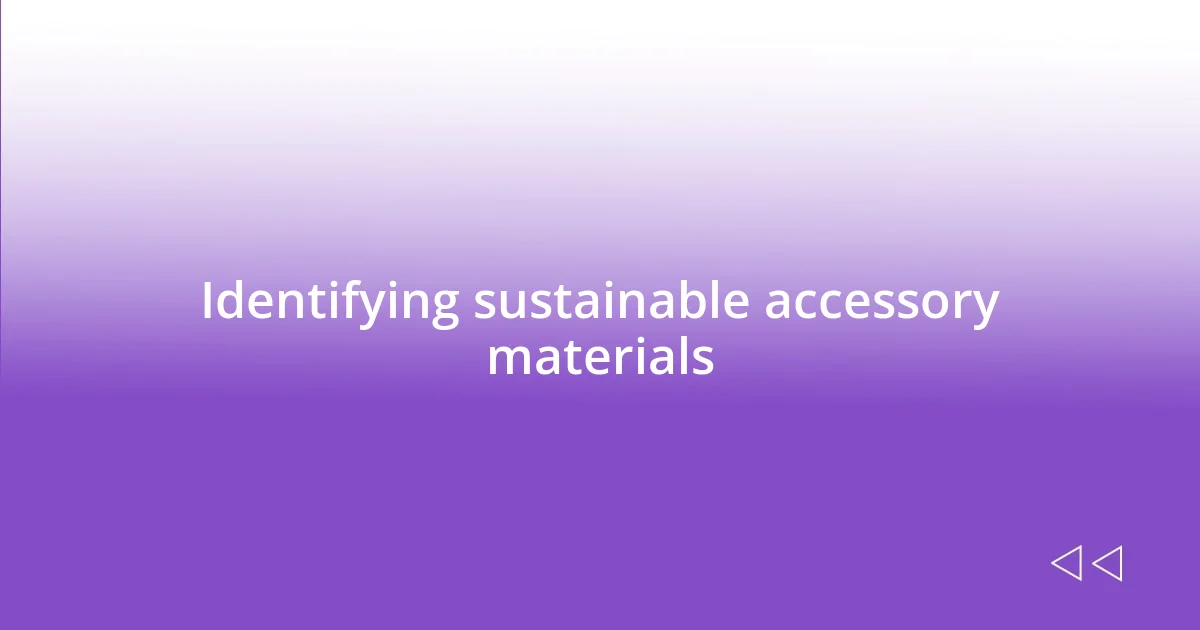
Identifying sustainable accessory materials
Identifying sustainable accessory materials can be both an enlightening and fulfilling journey. Recently, I stumbled upon a brand that utilizes Piñatex, a leather alternative made from pineapple leaves. This discovery resonated with me because it highlighted how sustainable materials can also support local economies. The use of natural fibers not only reduces reliance on harmful processes but also offers unique textures and visual appeal.
Here are some materials I’ve found to be consistently sustainable:
- Organic Cotton: Grown without synthetic pesticides, conserving water and promoting soil health.
- Recycled Polyester: Made from recycled plastic bottles, reducing waste and energy consumption.
- Hemp: Requires minimal water and pesticides, and it grows quickly, making it an eco-friendly choice.
- Tencel (Lyocell): A biodegradable fiber produced from sustainably sourced wood pulp through a closed-loop process.
- Cork: Harvested from the bark of cork trees, it’s renewable and biodegradable, offering a unique aesthetic.
Discovering and choosing these materials adds a deeper layer to my accessory selection, making each item not just an accessory but a piece of a larger sustainability narrative.

Evaluating ethical brands and producers
Evaluating ethical brands and producers is a crucial step in ensuring our fashion choices resonate with our values. I remember a time when I encountered a brand that claimed to be sustainable, only to discover later that their ethical practices were merely marketing fluff. It taught me the importance of digging deep into a brand’s story—checking their certifications and understanding their supply chains. This process can be surprisingly rewarding, as it aligns my purchases with brands that genuinely prioritize ethical practices.
I often ask myself, “What makes a brand truly ethical?” This question drives me to explore their labor practices, environmental impact, and community involvement. For instance, a brand I recently discovered not only uses eco-friendly materials but also actively supports artisans in developing countries. Their transparency about wages and working conditions made me feel connected to the very essence of my purchases, transforming consumerism into a collaborative effort for positive change.
I’ve also found it helpful to compare brands side by side. It allows me to see where each stands in terms of ethical values, and I can prioritize those that genuinely resonate with me. This analytical approach has made shopping for sustainable accessories feel less like a chore and more like a purposeful choice, enriching my experience as a conscious consumer.
| Brand | Ethical Rating |
|---|---|
| Brand A | Excellent – Fair Trade Certified |
| Brand B | Good – Uses Recycled Materials |
| Brand C | Fair – Minimal Transparency |
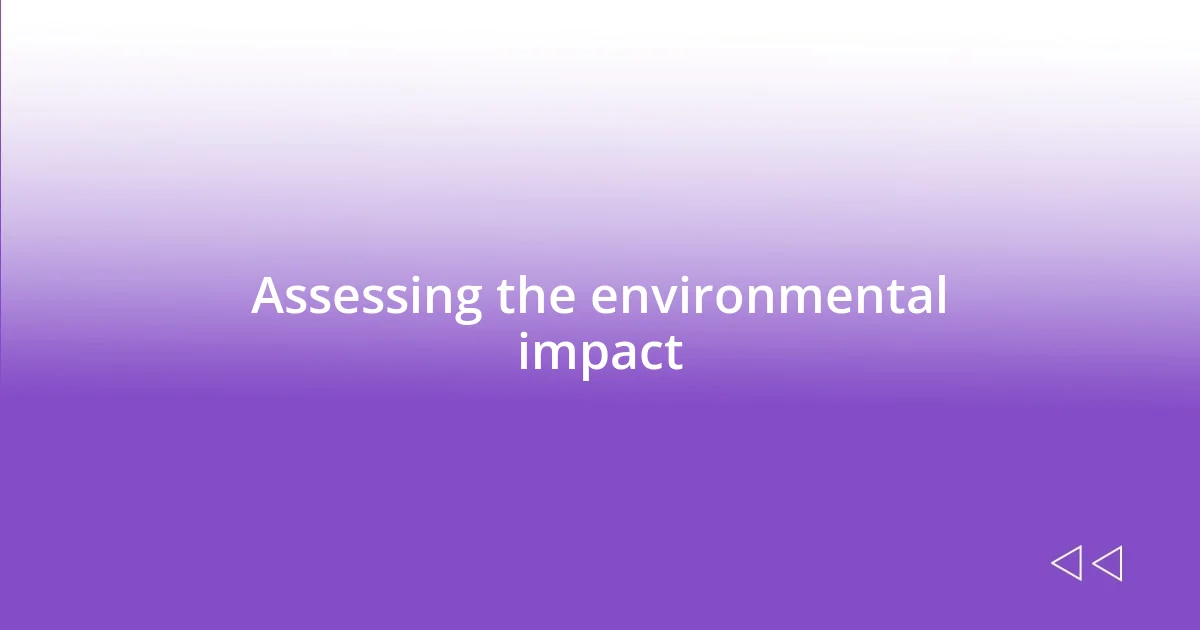
Assessing the environmental impact
Assessing the environmental impact of accessories is an eye-opening experience. Recently, I considered purchasing a trendy bag but paused to investigate its lifecycle. Was it made from durable materials? How would it affect the planet after its use? This moment of reflection made me realize that each purchase is not merely about style; it’s about the broader consequences for our environment.
I often find myself pondering the carbon footprint of accessories. For example, I once learned that producing a single cotton bag can require nearly 2,700 liters of water, roughly enough for one person’s drinking needs for three years! This statistic shook me, prompting me to seek out items designed for longevity and lower environmental impact. Each time I pass by an accessory that doesn’t meet these criteria, I remind myself that my choices have the power to protect our planet, shaping my shopping habits significantly.
Moreover, I’ve become increasingly aware of production methods. When I discovered that some brands use energy-intensive processes, I couldn’t help but feel a sense of responsibility. It reinforced my commitment to supporting brands that embrace renewable energy sources and sustainable practices. Now, I make it a point to champion products that leave a minimal environmental footprint, knowing that my choices can indeed spark positive change within the industry.
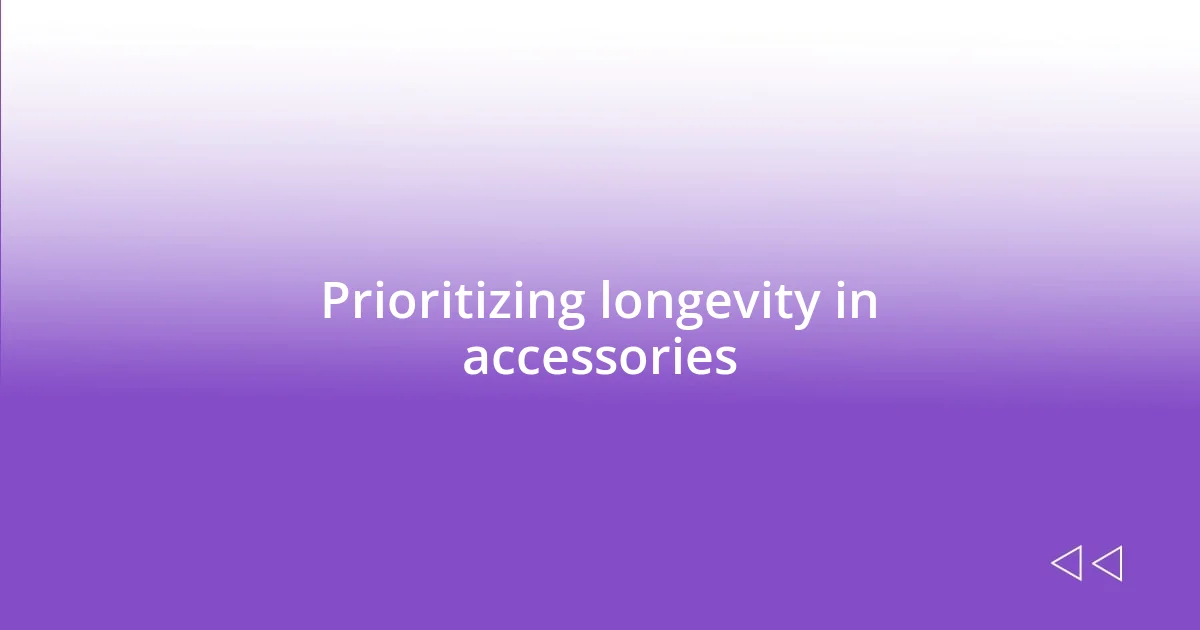
Prioritizing longevity in accessories
When I shop for accessories, the concept of longevity really stands out to me. I remember buying a leather wallet years ago, one I still use today because of its durability. It wasn’t just a purchase; it became a staple in my life, proving that investing in quality pieces pays off in the long run. This experience taught me that choosing items made from high-quality materials often leads to a more sustainable wardrobe.
I often wonder, “What’s the point of trends if they don’t last?” This question guides my selections towards timeless designs rather than fleeting fashions. I recall a time when I was tempted by a fast-fashion necklace. I eventually chose a handcrafted piece instead, knowing it was built to withstand the test of time. It made me feel connected to the craftsmanship involved, and I appreciate it every time I wear it, reinforcing my belief that accessories should be enduring.
Moreover, I’ve started to think critically about the stories behind my accessories. Each piece I own represents not just my style but also the values I uphold. Last month, I discovered a local artisan who creates minimalist rings that I instantly fell in love with. Their technique involves traditional methods that ensure durability while maintaining a stunning aesthetic. Choosing such pieces not only supports sustainable practices but also enriches my personal journey in fashion. I find that prioritizing longevity not only cultivates a more sustainable lifestyle but also deepens my connection to the items I cherish.

Integrating accessories into your wardrobe
Integrating accessories into my wardrobe has become a fulfilling journey. I still remember the first time I paired a bold statement necklace with a simple dress—it instantly elevated my look and boosted my confidence. Accessories, for me, are those magical tools that transform an outfit from basic to fabulous without requiring a complete wardrobe overhaul. They allow for personal expression while being mindful of my style and sustainability goals.
There’s a certain thrill in mixing various textures and colors, creating unique combinations that reflect my personality. I often ask myself, “How can I make this outfit truly mine?” One day, I grabbed my favorite vintage scarf and tied it around the handle of a thrifted bag. It added a pop of color, and I felt a sense of achievement knowing that I was upcycling pieces rather than buying new. These little creative touches can make a world of difference and help me avoid the monotony that comes with fast fashion.
I’ve also learned to curate my accessories based on versatility. When I stumbled upon a pair of eco-friendly earrings that could transition from day to night, it felt like a small win. I find that strategic choices help limit clutter while maximizing my style potential. By focusing on pieces that can be dressed up or down, I not only save space but also time in the morning. Am I the only one who secretly enjoys a little style challenge? Each accessory has become a puzzle piece that fits into my wardrobe, allowing me to explore different aspects of my identity while being conscious of my environmental footprint.
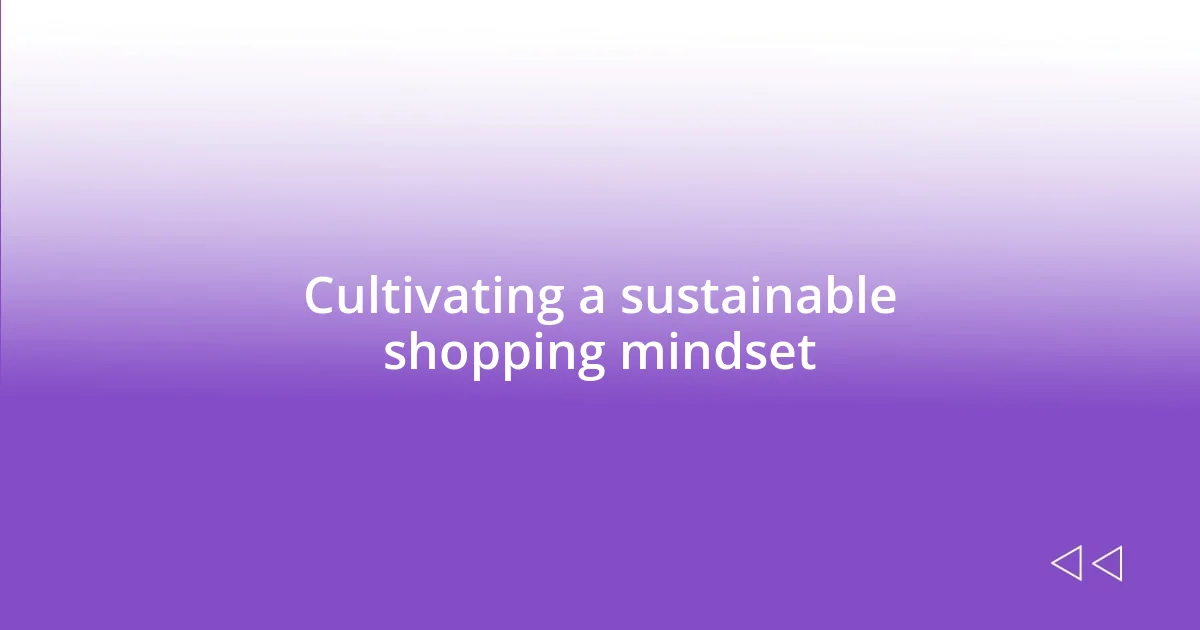
Cultivating a sustainable shopping mindset
Cultivating a sustainable shopping mindset really starts with intentionality. I remember the moment I decided to stop treating shopping as a pastime and instead view it as a way to express my values. Now, when I browse online or stroll through a store, I ask myself if the item aligns with my commitment to sustainability. It’s a grounding practice that transforms my shopping habits from impulse buys into thoughtful investments.
When I think about the impact of my choices, I can’t help but reflect on a recent experience at a local market. I found a beautiful, handwoven basket that caught my eye. As I learned about the artisan who crafted it, I felt a sense of connection to their story and the resources they used. This awareness made me appreciate not just the aesthetic of the piece, but also its environmental footprint. Embracing a sustainable mindset means celebrating these narratives behind each item, ultimately enriching my life with purpose and meaning.
I often ponder, “How can I make my wardrobe a reflection of my principles?” This question drives my decisions when selecting new pieces. It’s not always easy, especially with the pervasive influence of fast fashion, but I’ve learned that patience pays off. Instead of rushing to fill gaps in my closet, I take the time to research brands that prioritize ethical practices. With each conscious choice, I cultivate a sense of pride in my collection, knowing it aligns with my beliefs and positively impacts the planet.











